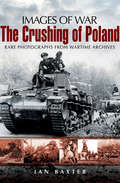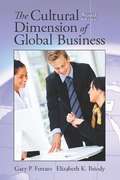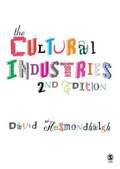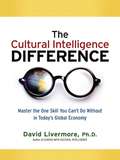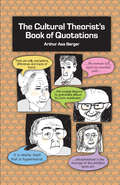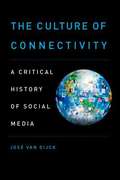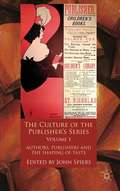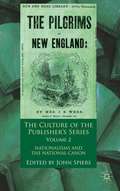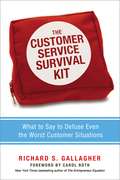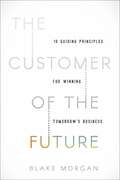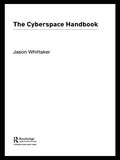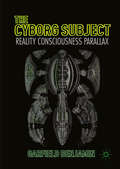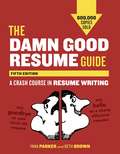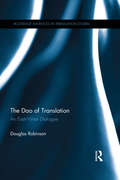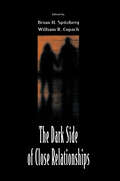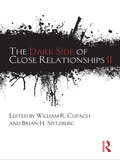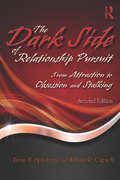- Table View
- List View
The Crushing of Poland: Rare Photographs from Wartime Archives (Images of War)
by Ian Baxter"Hitlers decision to invade Poland in August 1939 triggered the start of the Second World War. It was also the first demonstration of Blitzkrieg tactics the ruthless use of armor, mobile infantry and air support. The brave Polish army, inadequately equipped and inferior in numbers, was overwhelmed by this awesome display of military power as well as being taken by surprise. Official German photographers accompanied the triumphant Nazi forces on their victorious advance which first seized the key part of Danzig and then Warsaw, all within one month. The Crushing of Poland captures the drama and raw aggression of the Campaign in photographs and full captions."
The Cultural Context of Emotion
by Karl G. HeiderBased on the author's second stage of research on emotions of the matrilineal Moslem Minangkabau of West Sumatra, Indonesia, this book is a continuation of Heider's groundbreaking 1991 book, Landscapes of Emotion . This work demonstrates how situating emotion at the center of an investigation is a powerful ethnographic tool.
The Cultural Dimension of Global Business 7th Edition
by Gary P. Ferraro Elizabeth K. BriodyThe Cultural Dimension of Global Business provides a foundation for understanding the impact of culture on global business and global business on culture.
The Cultural Industries
by David Hesmondhalgh'The first edition of The Cultural Industries moved us irrevocably past the tired debates between political economy and cultural studies approaches. This second edition takes on new and vital targets, for example claims that the Internet is replacing television in everyday media consumption. . . . In the process, Hesmondhalgh provides us with an essential toolkit for making critical sense of the digital media age, and our places within it' - Nick Couldry, Goldsmiths College, University Of London 'This book sets a valuable standard for communication studies. Hesmondhalgh integrates cultural research with political economy, organizational sociology with public communication policy studies, global with comparative analysis, and intellectual property law with technology changes. I've successfully taught graduate and undergraduate courses in the USA and France using the first edition, and this one is better still' - John D. H. Downing, Global Media Research Centre, Southern Illinois University Praise for the first edition: 'This lucid, careful and sophisticated book orders the entire field, for the US as well as Europe, and at one stroke becomes the state of the art, the standard' - Todd Gitlin, Columbia University, USA This book is a powerful antidote to journalistic hype about change in the cultural industries. Significantly expanding, updating and revising an acclaimed first edition published in 2002, it · analyses how, why and in what ways cultural production has changed since the 1980s · guides the reader through existing approaches · scrutinises facts and debates about the role of culture and creativity in modern societies · provides new material on copyright, cultural policy, celebrity power, the digital distribution of music and many other issues Like its predecessor, this exciting new edition of The Cultural Industries places transformation in the cultural industries in long-term political, economic and cultural context. In doing so, Hesmondhalgh offers a distinctive critical approach to cultural production, drawing on political economy perspectives, but also on cultural studies, sociology and social theory.
The Cultural Intelligence Difference -Special eBook Edition: Master the One Skill You Can't Do Without in Today's Global Economy
by David LivermoreLearn how to master the one skill you can&’t do without in today&’s global economy.As an award-winning author and global business leader, David Livermore applies his social science and cultural intelligence (CQ) expertise to teach others how to thrive in increasingly multicultural workplaces and a globalized world. Now, in this essential book, he shows you how to leverage the benefits of cultural intelligence for themselves--including improved decision-making, negotiation, networking, and leadership skills--to gain a crucial advantage in the crowded job market.In The Cultural Intelligence Difference, you&’ll explore:customized strategies for improving interactions with people from diverse cultures,new findings on the bottom-line benefits of cultural intelligence,and many examples of major organizations that use CQ to achieve success.Most people know that some basic cultural sensitivity is important. But few have developed the deep cultural intelligence needed to truly bridge the cultural gaps that exist in every workplace.The Cultural Intelligence Difference delivers a powerful tool for navigating today's work world with finesse--and success.
The Cultural Theorist's Book of Quotations
by Arthur Asa BergerWhere did you see it—that perfect quotation from Foucault or Kristeva to use in your upcoming keynote address? Stop the search and pick up Arthur Berger’s handy book of over 300 concise quotations from the vast literature in cultural theory. This compilation will give you just the right snappy quote to help prepare that lecture, write that paper, fill that Power Point, or drop a few bon mots at a university reception. Organized by theoretical model (semiotic, Marxist, psychoanalytic, gender, postmodernist), Berger pulls together the most succinct, meaningful passages of the key theorists of our time for those wanting to distill cultural theory to its essence.
The Culture Industry and Participatory Audiences
by Emma KeltieThis project offers a new critique of participatory media practices. While the concept of participatory culture is often theorised as embodying the possibility of a potentially utopian future of media engagement and participation, this book argues that the culture industry, as it adapts and changes, provides moments of authorised participation that play out under the dominance of the industry. Through a critical recounting of the experience of creating a web series in Australia (with a global audience) outside of the culture industry structures, this book argues participation can take place. It is these platforms that become spaces of controlled access to participatory cultural practices.
The Culture Of Connectivity: A Critical History Of Social Media
by Jose Van DijckSocial media has come to deeply penetrate our lives: Facebook, YouTube, Twitter and many other platforms define many of our daily habits of communication and creative production. The Culture of Connectivity studies the rise of social media in the first decade of the twenty-first century up until 2012, providing both a historical and a critical analysis of the emergence of major platforms in the context of a rapidly changing ecosystem of connective media. Such history is needed to understand how these media have come to profoundly affect our experience of online sociality. The first stage of their development shows a fundamental shift. While most sites started out as amateur-driven community platforms, half a decade later they have turned into large corporations that do not just facilitate user connectedness, but have become global information and data mining companies extracting and exploiting user connectivity. Author and media scholar Jose van Dijck offers an analytical prism to examine techno-cultural as well as socio-economic aspects of this transformation. She dissects five major platforms: Facebook, Twitter, Flickr, YouTube, and Wikipedia. Each of these microsystems occupies a distinct position in the larger ecology of connective media, and yet, their underlying mechanisms for coding interfaces, steering users, and filtering content rely on shared ideological principles. At the level of management and organization, we can also observe striking similarities between these platforms' shifting ownership status, governance strategies, and business models. Reconstructing the premises on which these platforms are built, this study highlights how norms for online interaction and communication gradually changed. "Sharing," "friending," "liking," "following," "trending," and "favoriting" have come to denote online practices imbued with specific technological and economic meanings. This process of normalization, the author argues, is part of a larger political and ideological battle over information control in an online world where everything is bound to become social. Crossing lines of technological, historical, sociological, and cultural inquiry, The Culture of Connectivity will reshape the way we think about interpersonal connection in the digital age.
The Culture of Translation in Early Modern England and France, 1500–1660
by Tania Demetriou Rowan TomlinsonThis book explores modalities and cultural interventions of translation in the early modern period, focusing on the shared parameters of these two translation cultures. Translation emerges as a powerful tool for thinking about community and citizenship, literary tradition and the classical past, certitude and doubt, language and the imagination.
The Culture of the Publisher’s Series, Volume One
by John SpiersThis volume focuses on the publisher's series as a cultural formation - a material artefact and component of cultural hierarchies. Contributors engage with archival research, cultural theory, literary and bibliometric analysis (amongst a range of other approaches) to contextualize the publisher's series in terms of its cultural and economic work.
The Culture of the Publisher’s Series, Volume Two
by John SpiersThis volume explores problems concerning the series, national development and the national canon in a range of countries and their international book-trade relationships. Studies focus on issues such as the fabrication of a national canon, and on the book in war-time, the evolution of Catholic literature, imperial traditions and colonial libraries.
The Curse of the Mogul
by Ava Seave Bruce C. Greenwald Jonathan A. KneeIf Rupert Murdoch and Sumner Redstone are so smart, why are their stocks long-term losers? We live in the age of big Media, with the celebrity moguls telling us that "content is king." But for all the excitement, glamour, drama, and publicity they produce, why can't these moguls and their companies manage to deliver better returns than you'd get from closing your eyes and throwing a dart? The Curse of the Mogul lays bare the inexcusable financial performance beneath big Media's false veneer of power. By rigorously examining individual media businesses, the authors reveal the difference between judging a company by how many times its CEO is seen in SunValley and by whether it generates consistently superior profits. The book is packed with enough sharp-edged data to bring the most high-flying, hot-air filled mogul balloon crashing down to earth.
The Customer Service Survival Kit: What to Say to Defuse Even the Worst Customer Situations
by Richard GallagherIssues with customers can send even the most seasoned service professionals into red alert. Discover how to effectively communicate your way out of any difficult spot.By providing clear techniques, behavioral science insights, case studies, situation-specific advice, and actionable practice exercises, workplace communication expert Richard Gallagher has created a resource that can help anyone master the delicate art of communication.In The?Customer Service Survival Kit, you&’ll find tangible tips and tricks to help you discover:how to lean into criticism,how to avoid trigger phrases that can make bad situations worse,the secret to helping people feel heard,how to safely deliver bad news,and how to become immune to intimidation--among many other skills.The Customer Service Survival Kit recognizes that the worst customer situations demand more of front-line employees than good intentions and the right attitude. With the help of these valuable insights, lessons, and indispensable problem-solving tools, your organization holds the key to radically improving its customer service reputation.
The Customer of the Future: 10 Guiding Principles for Winning Tomorrow's Business
by Blake MorganTomorrow’s customers need to be targeted today!With emerging technology transforming customer expectations, it’s more important than ever to keep a laser focus on the experience companies provide their customers.In The Customer of the Future, customer experience futurist Blake Morgan outlines ten easy-to-follow customer experience guidelines that integrate emerging technologies with effective strategies to combat disconnected processes, silo mentalities, and a lack of buyer perspective.Tomorrow’s customers will insist on experiences that make their lives significantly easier and better. Companies will win their business not by just proclaiming that customer experience is a priority but by embedding a customer focus into every aspect of their operations. They’ll understand how emerging technologies like artificial intelligence (AI), automation, and analytics are changing the game and craft a strategy to integrate them into their products and processes.The Customer of the Future explains how today’s customers are already demanding frictionless, personalized, on-demand experiences from their products and services, and companies that don’t adapt to these new expectations won’t last. This book prepares your organization for these increasing demands by helping you do the following:Learn the ten defining strategies for a customer experience–focused company.Implement new techniques to shift the entire company from being product-focused to being customer-focused.Gain insights through case studies and examples on how the world’s most innovative companies are offering new and compelling customer experiences.Craft a leadership development and culture plan to create lasting change at your organization.
The Cyberspace Handbook
by Jason WhittakerThe Cyberspace Handbook is a comprehensive guide to all aspects of new media, information technologies and the internet. It gives an overview of the economic, political, social and cultural contexts of cyberspace, and provides practical advice on using new technologies for research, communication and publication. The Cyberspace Handbook includes: *a glossary of over eighty key terms*a list of over ninety web resources for news and entertainment, new media and web development, education and reference, and internet and web information* specialist chapters on web design and journalism and writing on the web*Over thirty illustrations of internet material and software applications.Jason Whittaker explores how cyberspace has been constructed, how it is used and extends into areas as different as providing us immediate news or immersive games and virtual technologies for areas such as copyright and cybercrime, as well as key skills in employing the internet for research or writing and designing for the Web.
The Cyborg Subject
by Garfield BenjaminThis book outlines a new conception of the cyborg in terms of consciousness as the parallax gap between physical and digital worlds. The contemporary subject constructs its own internal reality in the interplay of the Virtual and the Real. Reinterpreting the work of Slavoj Žižek and Gilles Deleuze in terms of the psychological and ontological construction of the digital, alongside the philosophy of quantum physics, this book offers a challenge to materialist perspectives in the fluid cyberspace that is ever permeating our lives. The inclusion of the subject in its own epistemological framework establishes a model for an engaged spectatorship of reality. Through the analysis of online media, digital art, avatars, computer games and science fiction, a new model of cyborg culture reveals the opportunities for critical and creative interventions in the contemporary subjective experience, promoting an awareness of the parallax position we all occupy between physical and digital worlds.
The DK Handbook Second Edition with Exercises
by Dennis A. Lynch Anne Frances WysockiTransforming expectations for textbooks, The DK Handbook with Exercises 2/e presents information in newly accessible, scientifically tested, and student-friendly ways. Never before seen in the handbook market, The DK Handbook's design is a true marriage of visual and textual content, in which each topic is presented in self-contained, two-page spreads for at-a-glance referencing. Explanations are concise and "chunked" to be more approachable and appealing for today's readers, and accompanying visuals truly teach - making concepts and processes visible to students. The ground-breaking layout creates a consistent look and feel that helps students connect with the material, find information, and recognize solutions to writing problems they often don't have names for.
The Daily Carrot Principle: 365 Ways to Enhance Your Career and Life
by Adrian Gostick Chester EltonFrom the authors of the smash bestseller The Carrot Principle comes an inspiring and lively page-a-day guide to harnessing the remarkable power of the carrot--taking yourself and your team to new heights of success in work and life.Based on their twenty years of experience teaching leaders at Fortune 100 companies, as well as one of the largest research studies ever conducted on workplace satisfaction, Gostick and Elton share a wealth of wisdom about simple but amazingly effective ways to boost your productivity and work satisfaction by setting clear goals, communicating effectively, building trust, and offering recognition in ways that make others feel appreciated and motivated.Each engaging page of The Daily Carrot Principle features a core kernel of wisdom, enlivened by thoughtful and witty quotes from the likes of Thomas Edison, Rosabeth Moss Kanter, Jim Collins, and Oprah Winfrey, plus a bonanza of insights from standout managers and employees the authors have studied. An easy-to-implement "carrot action" ends each page, providing the simple steps to begin applying this wealth of wisdom immediately.Whether you are a business leader, team member, student, mom or dad, or anyone hoping to achieve more in your life, this book will be an inspiring and practical guide to unleashing your hidden potential and leading a richer life.
The Damn Good Resume Guide, Fifth Edition: A Crash Course in Resume Writing
by Beth Brown Yana ParkerOne of the best-selling resume books of all time and a trusted resource for job-seekers for nearly three decades, this edition of The Damn Good Resume Guide has been completely revised and updated for today's marketplace.One of the best-selling resume books of all time and a trusted resource for job-seekers for nearly three decades, this edition of The Damn Good Resume Guide has been completely revised and updated for today's marketplace.The Shortest Distance Between You and Your Next Job For hundreds of thousands of job seekers, The Damn Good Resume Guide has been the go-to resource for writing and refining their resumes to damn near perfection. Filled with savvy advice and written in a straightforward, user-friendly style, The Damn Good Resume Guide will help you zero in on that dream job, then craft a winning resume that gets your foot in the door. This tried-and-true best seller has been fully revised and updated for today's job market, including: Contemporary sample resumes (all of which landed interviews!) with job objectives running the career gamut--from line cook to sales manager, school principal to software engineer.Tips on creating a functional, chronological, or hybrid resume--and advice on choosing which format is best for you.What to include and what to leave out of your resume, so you get the job you really want.Smart ways to deal with gaps in your work history and other less-than-ideal resume scenarios.Instructions for writing cover emails and submitting resumes electronically.How to set up (and excel at) an informational interview.Advice for formatting, polishing, and proofing your resume so that it stands out in the right way.And much more!Follow Parker and Brown's ten easy steps, and you'll be well on your way to a smart, effective, and thoroughly modern resume--a resume that makes you look good and produces results.
The Dao of Translation: An East-West Dialogue (Routledge Advances in Translation and Interpreting Studies)
by Douglas RobinsonThe Dao of Translation sets up an East-West dialogue on the nature of language and translation, and specifically on the "unknown forces" that shape the act of translation. To that end it mobilizes two radically different readings of the Daodejing (formerly romanized as the Tao Te Ching): the traditional "mystical" reading according to which the Dao is a mysterious force that cannot be known, and a more recent reading put forward by Sinologists Roger T. Ames and David L. Hall, to the effect that the Dao is simply the way things happen. Key to Ames and Hall’s reading is that what makes the Dao seem both powerful and mysterious is that it channels habit into action—or what the author calls social ecologies, or icoses. The author puts Daoism (and ancient Confucianism) into dialogue with nineteenth-century Western theorists of the sign, Charles Sanders Peirce and Ferdinand de Saussure (and their followers), in order to develop an "icotic" understanding of the tensions between habit and surprise in the activity of translating. The Dao of Translation will interest linguists and translation scholars. This book will also engage researchers of ancient Chinese philosophy and provide Western scholars with a thought-provoking cross-examination of Eastern and Western perspectives.
The Dark Side of Close Relationships
by William R. Cupach Brain H. SpitzbergThis collection of essays represents a follow-up to the editors' 1994 publication, The Dark Side of Interpersonal Communication. In the preface to that collection of essays, they argued that "To fully understand how people function effectively requires us to consider how individuals cope with social interaction that is difficult, problematic, challenging, distressing, and disruptive." In this companion volume, the focus expands from social interaction to close relationships. Aside from the inherent need to investigate the bad as well as the good of interpersonal relationships, the editors and their colleagues simply find the dark side metaphor to be intellectually arousing. It stimulates investigation of important yet often neglected phenomena, and it especially encourages consideration of the hidden and forbidden, and the paradoxical and ironic elements of human relating. This volume assembles the cutting-edge work of first rate scholars from the ranks of communication, psychology, sociology, and cognate disciplines. As in the previous text, the subject matter and stylistic approaches are diverse, reflecting the broad and interdisciplinary domain that is the dark side of human affairs. The selection of topics is somewhat selective, reflecting only a sample of emerging scholarship in the interdisciplinary study of relationships. These internationally recognized scholars examine various topics related to the dark side, including fatal attractions, jealousy and envy, misunderstanding, gossip, conflict, codependence, sexual coercion, stalking, relationship termination, unrequited love, and mental health problems in relationships. Some chapters present original data and models, whereas others reconfigure the way in which the understandings of relationships can be better understood. In addition, the bookend chapters examine the ideology, nature, and problems of dark side scholarship. Collectively, the scholarly journeys made in this volume are intended to illustrate the complexities--both moral and functional--involved in close relationship processes. The intent is neither to valorize nor demonize the darker aspects of close relationships, but rather to emphasize their importance to the day-to-day "doing" of relationships. Only by accepting such processes as integral to relationships can their role be fully understood.
The Dark Side of Close Relationships II
by William R. Cupach Brian H. SpitzbergThe Dark Side of Close Relationships II is a completely new and up-to-date version of the original volume published in 1998, featuring new topics and authors. The volume showcases cutting-edge work on important topics by prominent scholars in multiple disciplines. It sheds light on the paradoxical, dialectical, and mystifying facets of human interaction, not merely to elucidate dysfunctional relationship phenomena, but to help readers explore and understand it in relation to a broader understanding about relationships. As previous Dark Side investigations have revealed, negative or dysfunctional outcomes can occur in relationships even though positive and functional ones are expected, and at the same time, positive silver linings are often found in some dark relational clouds. Such nuanced approaches are needed to better account for the complexity of close relationships. A unique and provocative collection, this volume will appeal to relationship researchers in communication, social psychology, family studies, and sociology.
The Dark Side of Interpersonal Communication
by William R. Cupach Brian H. SpitzbergThe Dark Side of Interpersonal Communication examines the multifunctional ways in which seemingly productive communication can be destructive—and vice versa—and explores the many ways in which dysfunctional interpersonal communication operates across a variety of personal relationship contexts. This second edition of Brian Spitzberg and William Cupach’s classic volume presents new chapters and topics, along with updates of several chapters in the earlier edition, all in the context of surveying the scholarly landscape for new and important avenues of investigation. Offering much new content, this volume features internationally renowned scholars addressing such compelling topics as uncertainty and secrecy in relationships; the role of negotiating self in cyberspace; criticism and complaints; teasing and bullying; infidelity and relational transgressions; revenge; and adolescent physical aggression toward parents. The chapters are organized thematically and offer a range of perspectives from both junior scholars and seasoned academics. By posing questions at the micro and macro levels, The Dark Side of Interpersonal Communication draws closer to a perspective in which the darker sides and brighter sides of human experience are better integrated in theory and research. Appropriate for scholars, practitioners, and students in communication, social psychology, sociology, counseling, conflict, personal relationships, and related areas, this book is also useful as a text in graduate courses on interpersonal communication, ethics, and other special topics.
The Dark Side of Marketing Communications: Critical Marketing Perspectives (Routledge Studies in Critical Marketing)
by Tim Hill Pierre McDonaghWhat fuels capitalism and what stops it from collapsing? Does marketing communications support and sustain the economic and political status quo?This book is not about describing the ways in which businesses can optimize the messages they put across or about adding to the marketing communicator’s toolkit. This book argues that marketing communications plays an increasingly important role in bolstering contemporary capitalism. Drawing on conceptualizations of the ‘market’ from political economy and sociology, it focusses on five logics that underpin and sustain the form of capitalism in which we live: the logic of competition, the logic of sustainability, the logic of individualism, the logic of objectivity, and the logic of distraction. It does this by exploring those arenas which are increasingly dominated by the communicative activities of business: sport, CSR, social media, statistics, and entertainment.Bringing theories from marketing and consumer research, sociology, cultural studies, technology and media studies to bear on marketing communications, this book is necessary reading for undergraduate and postgraduate students and academics who wish to understand the broader role of marketing communications in the reproduction of contemporary capitalism.
The Dark Side of Relationship Pursuit: From Attraction to Obsession and Stalking
by William R. Cupach Brian H. SpitzbergAwards and Praise for the first edition: Recipient of the 2006 International Association for Relationship Research (IARR) Book Award "This text, as it presently stands, is THE go-to text for stalking researchers. That is my opinion and the opinion of multiple fellow scholars I know in the field. It rarely sits on my shelf, but rather is a constant reference on my desk. I can always count on these authors to have done an extensive review of literature. I thought I was thorough, but they are always providing me with new references."--Dr. H. Colleen Sinclair, Associate Professor of Psychology, Mississippi State University "Cupach and Spitzberg provide the reader with a multidisciplinary framework for understanding the nature and impact of unwanted relationship pursuits. This book is an excellent resource for students and professionals alike who seek to gain knowledge about unwanted relational pursuits and stalking." —Journal of Couple & Relationship Therapy The Dark Side of Relationship Pursuit provides historical and definitional frames for studying unwanted relationship pursuit, and considers the role of the media, law, and social science research in shaping today’s conceptualizations of stalking. The volume integrates research from diverse contributing fields and disciplines, providing a thorough summary and assessment of current knowledge on stalking and obsessive pursuit. Building on the foundation of the award-winning first edition, this revision considers assessment issues, offers an expanded analysis of the meta-analysis data set, and includes coverage of intercultural and international factors. As an increasing number of scholarly disciplines and professional fields study stalking and other forms of obsessive relationship pursuit, this book is a must-have resource for examining interpersonal conflict, social and personal relationships, domestic violence, unrequited love, divorce and relational dissolution, and harassment. It also has much to offer researchers, counselors, and professionals in psychology, counseling, criminal justice, sociology, psychiatry, forensic evaluation, threat assessment, and law enforcement.
